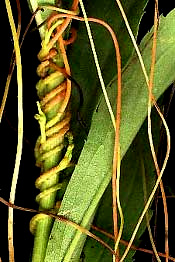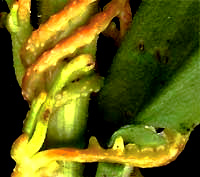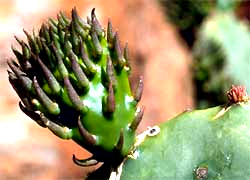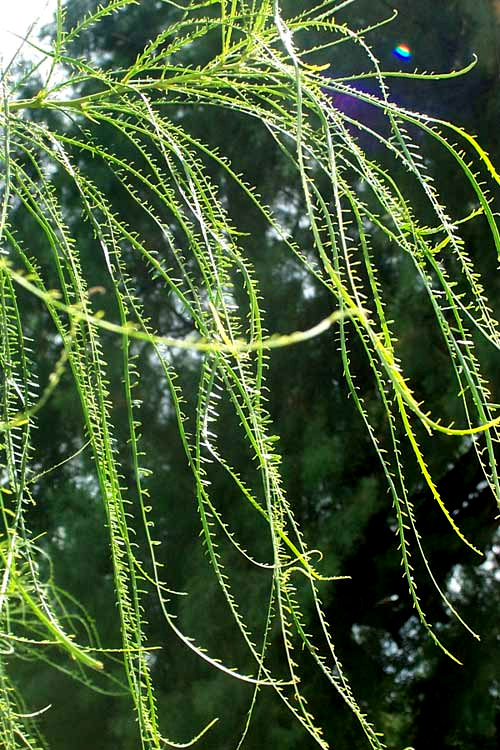
Some flowering plants don't have leaves. At the right you the see orange-colored, threadlike, parasitic flowering plant called Dodder (genus Cuscuta, which produces no leaves. Dodder twines all over various kinds of plants sinking rootlike haustoria into the host plants' tissues. The host plants' nutrient-rich fluids then flow into the dodder, so the dodder doesn't need photosynthesizing leaves.  At the left, the close-up shows dodder's haustoria penetrating the host-plant's leaves and stem. About 170 species of dodder are known, plus there's the genus Cassytha with 17 species in the Laurel Family looking and behaving very much like dodder, so leafless parasitic plants often are seen in Nature.
At the left, the close-up shows dodder's haustoria penetrating the host-plant's leaves and stem. About 170 species of dodder are known, plus there's the genus Cassytha with 17 species in the Laurel Family looking and behaving very much like dodder, so leafless parasitic plants often are seen in Nature.

Some plants bear leaves so reduced in size and so modified that they at least look leafless. That's practically the case with the garden asparagus shown at the right. Those triangular scales are modified leaves. If you've grown asparagus or know the Wild Asparagus, you've seen that if you let the "spears," like those at the right, continue to grow, they'll branch and produce diffuse, green, leaf-like items. However, those items are not leaves, but rather modified stems called cladodes. The cladodes do photosynthesize, however.

At the left you see a very young, thumbnail-size cactus pad just beginning to grow atop an older pad. The slender, conical items covering the young pad are cactus leaves. As the pad matures and enlarges to about the size of a ping-pong paddle, the leaves will fall off, leaving behind spines that developed at the leaves' bases. The main body of a cactus is a modified stem. In flowering plants it's normal for leaves to arise from stems, so really it's not too surprising that cacti stems and leaves behave like this. Certain primitive cactus species still produce regular leaves.

Many desert plants bear leaves after rains but drop them when it's dry, even when that's most of the time. This keeps water from evaporating from the leaves' surfaces. At the right you see the very slender compound leaves of the Jerusalem-thorn, Parkinsonia aculeata. The more slender a leaf is, the less surface area per unit volume it has, which cuts down on water evaporation. In the desert when months pass without rain, the Jerusalem-thorn simply drops its leaves.